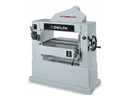
 Snipe most frequently attacks at the infeed end of a planed board. Snipe, however, is certainly not unknown to sneak-attack the outfeed end of your planed boards as well. It is tricky and devious, perhaps as elusive as its quite make-believe namesake, and can sometimes be surprisingly difficult to wrap your head own around – especially in the heat of a desperately upsetting snipe attack in which this invisible offender cuts your precious stock too deeply at one end or the other and makes a true mess of your life, your work, and your peace of mind.
Snipe most frequently attacks at the infeed end of a planed board. Snipe, however, is certainly not unknown to sneak-attack the outfeed end of your planed boards as well. It is tricky and devious, perhaps as elusive as its quite make-believe namesake, and can sometimes be surprisingly difficult to wrap your head own around – especially in the heat of a desperately upsetting snipe attack in which this invisible offender cuts your precious stock too deeply at one end or the other and makes a true mess of your life, your work, and your peace of mind.
But all is not dark clouds and shadows in the world of snipe, there are ways to reduce or even eliminate that pesky deep-cut. Learning, though, that snipe can most often be chalked up to operator error, can be even more frustrating than simply suffering its damages. You see, just like your kids, your best friend from high school, your dog, and even yourself, your stock needs a little bit of pressure to stay on the right path; a little bit of firm contact to ensure it doesn’t deviate from course.
If your stock isn’t fully supported as it moves in and out of your machine, another invisible force called gravity will act upon it pulling or forcing one end of your stock up (as the opposite end is forced down) as the board passes through the cutterhead. The more stock, or weight, you have outside the machine, the more likely it is that snipe will occur; in a motion similar to a teeter-totter or see-saw, the weight of the board pulls one end of the stock downward forcing the opposite end (still in the machine) to rise and meet the planer knivesat a greater height and pressure than the rest of the board.
This heated rendezvous between stock and planer knives is, essentially, snipe, and the result is a deeper cut at the ends of your board. This, of course, brings us to the planer knives themselves which by virtue of their cutting action, inflict a bit of lifting force upon your stock as well. This only further reinforces the need to keep your stock firmly on the planer bed as it passes through the machine.
At long last, catching or eliminating your snipe, ultimately hinges on your ability to keep pressure on your stock as it feeds entirely through your planer. In other words, keep the stock securely, like a rock, on your planer bed from the beginning of one end to the very end of the other. This does take a little effort and finesse but is absolutely worth it in the long run, and what’s more, you can absolutely do it.
As you begin to pass your stock through the machine, firmly press the front end of the board against the planer bed while also maintaining a few pounds of lifting pressure (simply by lifting the back end of the board) at the back end of your stock. Keep the stock securely flat to the bed until it reaches the second feed roller which will then apply the additional pressure needed. Keep the back end of the stock lifted until just about half the workpiece has fed through the machine and move to the outfeed side of your planer. Continue the above process on the outfeed side of your machine until the pass is complete.
This should drastically reduce any snipe attacks and may eliminate snipe to a mere blemish on the wood surface that can be quickly sanded out.













